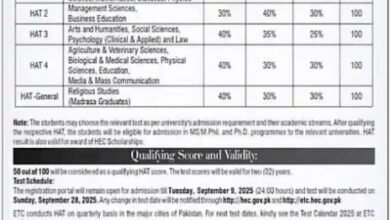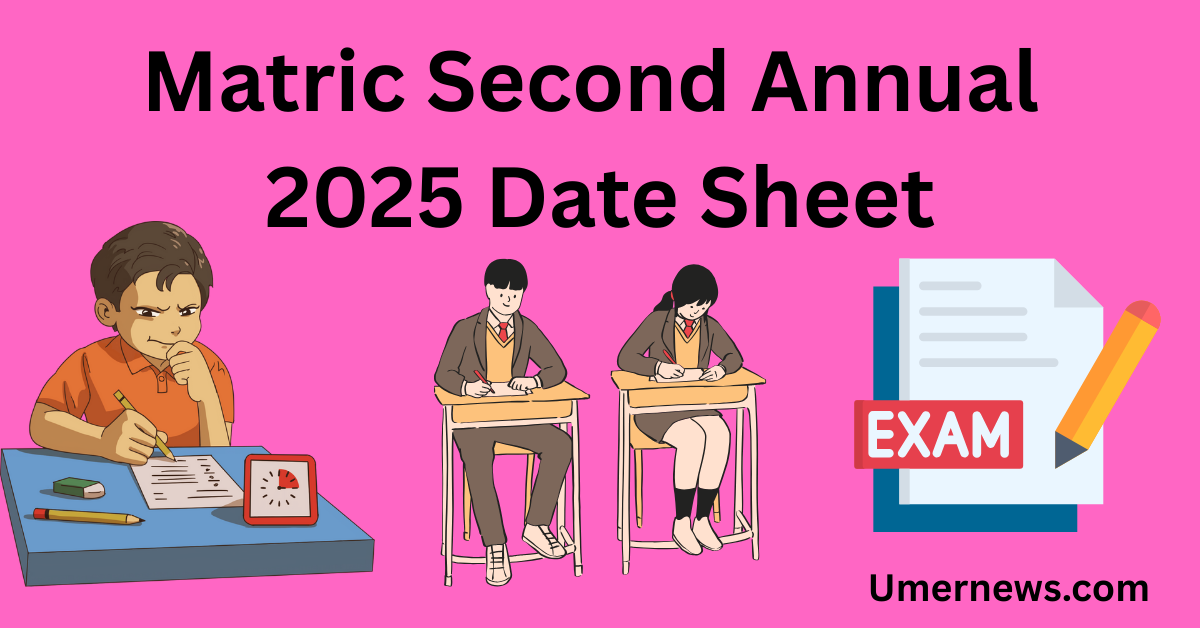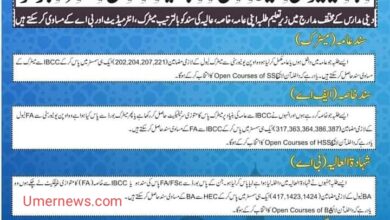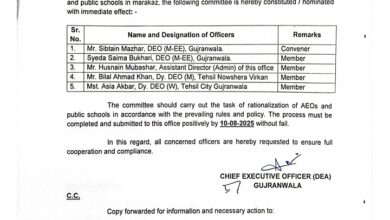Khyber Pakhtunkhwa Education Department Teacher Rationalization Policy 2025
Contents
- 1 Khyber Pakhtunkhwa Education Department Teacher Rationalization Policy 2025: A Comprehensive Guide
- 1.1 Overview of the Teacher Rationalization Policy
- 1.2 Policy Rules for Teacher Allocation
- 1.3 Teacher Transfer and Rationalization Process
- 1.4 Implications of the Rationalization Policy
- 1.5 FAQs About the KP Teacher Rationalization Policy 2025
- 1.5.1 What is the purpose of the teacher rationalization policy?
- 1.5.2 How are surplus teachers identified?
- 1.5.3 Who is transferred under the policy?
- 1.5.4 What is the deadline for submitting data for rationalization?
- 1.5.5 How does the policy ensure fairness?
- 1.5.6 Where can I find more details about the policy?
- 1.6 Conclusion
Khyber Pakhtunkhwa Education Department Teacher Rationalization Policy 2025: A Comprehensive Guide

The Khyber Pakhtunkhwa (KP) Education Department has introduced a teacher rationalization policy for 2025 to optimize teacher allocation across primary schools, ensuring equitable access to quality education. This policy aligns with the department’s mission to strengthen the public education system through transparent governance and effective resource utilization. By August 15, 2025, the department seeks comprehensive data to implement this policy, addressing disparities in teacher distribution based on student enrollment. This article explores the policy’s rules, implications, and processes, incorporating insights from authoritative sources to provide a clear and detailed overview.
Overview of the Teacher Rationalization Policy
The KP Education Department’s rationalization policy aims to balance teacher-student ratios in primary schools, including JICA-supported institutions, to enhance educational outcomes. The policy addresses the uneven distribution of teachers, ensuring that schools with varying student populations have adequate staff. It emphasizes fairness by prioritizing seniority and proximity during teacher transfers, aligning with the province’s commitment to inclusive and equitable education as outlined on the Elementary & Secondary Education Department KP website.
Key Objectives
- Optimize Teacher Allocation: Ensure schools have the right number of teachers based on student enrollment.
- Enhance Educational Quality: Improve classroom learning by maintaining appropriate teacher-student ratios.
- Promote Equity: Adjust surplus teachers to schools with shortages, prioritizing local adjustments.
- Transparent Governance: Use data-driven decisions to streamline teacher transfers.
Policy Rules for Teacher Allocation
The rationalization policy sets clear guidelines for teacher allocation in primary schools, including both male and female institutions, based on student numbers. Below are the detailed rules:
Rule 1: Teacher Allocation for JICA Primary Schools
JICA-supported primary schools follow a structured staffing model based on student enrollment:
- 1 to 100 Students: 5 teachers (1 SST, 2 CTs, 2 PSTs/SPSTs)
- 101 to 140 Students: 6 teachers (1 SST, 2 CTs, 3 PSTs/SPSTs)
Rule 2: Minimum Teacher Requirement
- Every primary school (male and female) must have at least two teachers:
- 1 Primary School Head Teacher (PSHT)
- 1 Primary School Teacher (PST) or Senior Primary School Teacher (SPST)
Rule 3: Teacher Allocation Based on Student Numbers
For all primary schools, the number of teachers is determined by student enrollment:
- 1 to 100 Students: 2 teachers
- 101 to 140 Students: 3 teachers
- 141 to 180 Students: 4 teachers
- 181 to 220 Students: 5 teachers
- 221 to 260 Students: 6 teachers
- Mandatory Requirement: One PSHT is required in every school, with additional teachers being PSTs or SPSTs.
Teacher Allocation Table
| Student Enrollment | Number of Teachers | Composition (JICA Schools) | Composition (Other Primary Schools) |
|---|---|---|---|
| 1–100 | 2 | 1 SST, 1 CT, 0 PST/SPST | 1 PSHT, 1 PST/SPST |
| 101–140 | 3 (Non-JICA) / 6 (JICA) | 1 SST, 2 CTs, 3 PSTs/SPSTs | 1 PSHT, 2 PSTs/SPSTs |
| 141–180 | 4 | N/A | 1 PSHT, 3 PSTs/SPSTs |
| 181–220 | 5 | N/A | 1 PSHT, 4 PSTs/SPSTs |
| 221–260 | 6 | N/A | 1 PSHT, 5 PSTs/SPSTs |
Teacher Transfer and Rationalization Process
The policy outlines a systematic approach to transferring surplus teachers to ensure optimal staffing. The process prioritizes seniority and proximity to minimize disruption, as detailed below:
Transfer Criteria
- Surplus Teachers: Schools with more teachers than required (based on student numbers) will transfer the most junior teacher in terms of service.
- Priority for Adjustment:
- Nearest School: Surplus teachers are first adjusted to the closest school with a vacancy.
- Same Union Council: If no vacancy exists in the nearest school, teachers are reassigned within the same union council.
- Circle, Tehsil, or District: If no vacancies are available in the union council, teachers are transferred within the circle, tehsil, or district, in that order.
- Seniority-Based Retention: The senior-most teacher is retained in their current school, while the junior-most is transferred.
Example Scenario
If a school with 80 students has three teachers (1 PSHT, 2 PSTs) but requires only two, the junior-most PST will be transferred to the nearest school with a vacancy. If no vacancy exists nearby, the teacher may be reassigned within the union council, circle, tehsil, or district, based on need.
Implications of the Rationalization Policy
The policy aligns with the KP government’s vision of fostering a skilled and qualified public, as emphasized on the KP Official Web Portal. By ensuring that teacher distribution matches student needs, the policy aims to:
- Improve Learning Outcomes: Adequate teacher numbers enhance classroom engagement and personalized attention.
- Address Teacher Shortages: Reallocating surplus teachers to understaffed schools reduces disparities.
- Support Professional Development: The policy complements ongoing teacher training initiatives, such as those offered by the Directorate of Professional Development (DPD).
However, concerns have been raised about past policies, such as the 2018 teacher induction policy, which devalued professional education degrees. The current rationalization policy does not explicitly address this issue, but it emphasizes transparent and merit-based processes, potentially mitigating such criticisms.
FAQs About the KP Teacher Rationalization Policy 2025
What is the purpose of the teacher rationalization policy?
The policy aims to balance teacher distribution in KP primary schools based on student enrollment, ensuring equitable access to quality education.
How are surplus teachers identified?
Surplus teachers are identified in schools where the number of teachers exceeds the required number based on student enrollment (e.g., 2 teachers for 1–100 students).
Who is transferred under the policy?
The most junior teacher in terms of service is transferred to a school with a vacancy, prioritizing the nearest location.
What is the deadline for submitting data for rationalization?
The KP Education Department has set a deadline of August 15, 2025, for schools to submit data for rationalization.
How does the policy ensure fairness?
The policy prioritizes seniority, ensuring senior teachers remain in their current schools, and uses a structured transfer process to minimize disruption.
Where can I find more details about the policy?
Visit the Elementary & Secondary Education Department KP website or the ETEA website for official notifications and updates.
Conclusion
The Khyber Pakhtunkhwa Education Department’s teacher rationalization policy for 2025 is a strategic step toward optimizing teacher distribution and enhancing educational quality in primary schools. By aligning teacher numbers with student enrollment and prioritizing seniority and proximity in transfers, the policy ensures fairness and efficiency. Schools must submit data by August 15, 2025, to facilitate this process. As the province continues to invest in education, as highlighted by initiatives like those on the ETEA website, this policy reinforces KP’s commitment to equitable and inclusive education, paving the way for a skilled and empowered future generation.
:محکمہ تعلیم ریشنلائزیشن
محکمہ تعلیم خیبرپختونخوا کا ٹیچرز کی ریشنلائزیشن کیلئے 15 اگست 2025 تک ڈیٹا طلب
ریشنلائزیشن پالیسی رولز
1۔۔۔۔۔اگر پرائمری ( JICA) سکول میں تعداد 1 سے 100 ہو تو ٹوٹل 5 ٹیچرز ہونگے ( ایک SST, دو CTs, دو PSTs/SPSTs) جبکہ
تعداد 101 سے 140 ہو تو 6 ٹیچرز ہونگے۔ (ایک SST, دو CTs, تین PSTs/SPSTs)
2۔۔۔۔۔ہر پرائمری (میل و فیمیل) سکول میں کم از کم دو ٹیچرز لازمی ہیں۔ ایک PSHT اور ایک PST یا SPST
3۔۔۔۔۔پرائمری (میل و فیمیل) سکولز میں طلبہ تعداد 1 سے 100 تک ہو تو 2 ٹیچرز ہونگے
تعداد 101 سے 140 ہو تو 3
تعداد 141 سے 180 ہو تو 4
تعداد 181 سے 220 کیلئے 5 جبکہ
221 سے 260 تعداد کیلئے 6 ٹیچرز ہونگے۔ ہر سکول میں ایک PSHT لازمی ہے جبکہ دیگر میں PST یا SPSTs ہوسکتے ہیں۔
ریشنلائزیشن کے وقت پالیسی رولز کیمطابق جن سکولز میں سٹوڈنٹس کی تعداد کم اؤر ٹیچرز کی تعداد مقررہ تعداد سے زیادہ ہو تو
سروس کے لحاظ سے سب سے جونیئر ٹیچر کو (زیادہ سٹوڈنٹس اؤر کم ٹیچرز والے) قریبی سکول ٹرانسفر کیا جائے گا۔
ریشنلائزیشن کرتے وقت سکولز میں سرپلس پرائمری ٹیچرز کو ترجیحاً پہلے قریب ترین سکول میں ایڈجسٹ کیا جائے گا تاہم
اگر قریب والے سکول میں خالی پوسٹ نہ ہو تو ضروت کیمطابق اسی ہی یونین کونسل
پھر بھی اگر نا ہو تو اپنے سرکل میں پھر تحصیل اؤر پھر ضرورت کیمطابق اپنے ڈسٹرکٹ میں کہیں بھی ایڈجسٹ کیا جاسکتا ہے۔
ریشنلائزیشن پالیسی کے تحت سرپلس ٹیچرز کی ٹرانسفر کرتے وقت سینیارٹی لسٹ کیمطابق جونیئر ترین ٹیچر کو دوسرے سکول ٹرانسفر کیا جائے گا جبکہ
سینئر موسٹ ٹیچر اپنے موجودہ سکول میں retain رہے گا۔








